Archive for January, 2016
“Fairy Tale Fashion” at The Museum at FIT
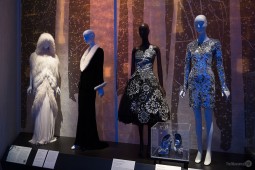
“Fairy Tale Fashion”, on show at The Museum at FIT through the 16th April 2016, is a highly imaginative exhibition which displays high fashion in the traditional settings of the most famous fairy tales.
Dress plays an important role in fairy tales, it could be the magical instrument through which the hero overcomes the struggles, or a symbol of power, status and vanity. The dress is used to portray the qualities of the characters, and similar characters from various fairy tales wear similar clothes. The fairy godmother, the misterious old lady, the beggar, the prince, the sorcerer, all are characterized by their particular looks. “Little Red Riding Hood” and “Cinderella” are maybe the most known examples, but in many other tales, such as “The Little Mermaid”, “The Beauty and the Beast” or “The Wizards of Oz” dress plays an important role.
The exhibition features more than 80 objects dating from the 18th century to the present, including the work of many 21st-century designers, whose creations distinguish themselves for their magical allure or oddity, like Thom Browne, Christian Louboutin, Dolce and Gabbana, Tom Ford, Giles, Mary Katrantzou, Marchesa, Alexander McQueen, Rick Owens, Prada, Rodarte, and Walter Van Beirendonck, among others. The exhibition is organized in thematic areas, that act as sets and are named “Forest”, “Castle”, “Sea” and “Parallel Worlds”. Every section displays the clothes representing the different tales.
In the exhibition’s introductory space are also displayed the artworks which have played a role in shaping the fairy tale aesthetic. These include illustrations by renowned early 20th-century artists such as Edmund Dulac, Arthur Rackham, and A.H. Watson, alongside recent, large-scale photographs from Kirsty Mitchell’s award-winning Wonderland series, which are shown for the first time in the USA in this exhibition.
For more information about “Fairy Tales Fashion”, visit The Museum at FIT. Browse also Europeana Fashion’s new Pinterest board with a selection of the most bizarre and magical looks from our collection!
New Board on Europeana Fashion Pinboard: Sportswear!
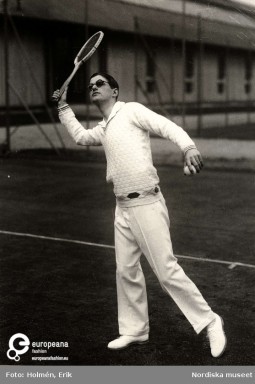
The new board now on Europeana Fashion’s Pinterest features the sportswear creations in Europeana Fashion’s collection!
In the twenty-first century, the word “sportswear” describes a broad category of garments developed for sporting activities. The history of sportswear, however, dates back to the 18th century, in which the hunt, horse riding and shooting were considered the main sports and were played by the aristocracy and by privileged people in the countryside. To take part to these activities, men wore more comfortable suits than those worn in the cities. These suits quickly became fashionable through the young gentlemen too, such as the redingote, which later become a fashionable dress for both men and women.
The popularity of sportswear grew in the early 20th century, a period in which sports were democratized and mass production and technical innovations made the ready-to-wear sportswear affordable to everyone. Migrants from Europe arrived in the States bringing their own sports, and American Clubs influenced fashion with the introduction of new practical garments for sports.
But it was only after World War I that sportswear became a fashionable choice also for women. In 1922 Jean Patou introduced sportswear in high fashion, as did Elsa Schiaparelli, when she designed her light sweaters with trompe l’oeil bows. Cinema helped to promote sportswear styles, and many female celebrities – not only actress, but also many athletes – wore their sportswear attires in public occasions or posed with it in magazines.
In the 1930s, many American designers, like Bonnie Cashin, Tina Leser, Vera Maxwell, Claire McCardell, Clare Potter, and Emily Wilkens turned into sportswear and contributed to shape an “American Look”, opposed to the French Couture. The “American look” was characterized by practical and democratic clothes and it became typical of American fashion through the 1990s.
Visit our Pinterest board to some of the most interesting example of our sportswear collection, and browse Europeana Fashion Theme area to see more unique sportswear records!
“Footprint. The Track of Shoes in Fashion” at MoMu
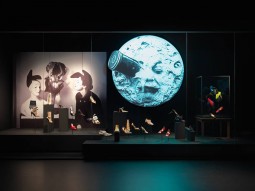
On show through the 14th of February, the exhibition held at MoMu – the Fashion Museum of the Province of Antwerp – tracks the shoes that have made the history of fashion.
The exhibition “Footprint. The Track of Shoes in Fashion” points out one of shoes’ main features, that of leaving an imprint. The shoes of the twentieth and twenty-first centuries now on show at MoMu left an imprint in fashion, could it be for their particular design, for their popularity, or because they marked down a specific moment in history.

SURREALISM - Magic and illusions, those realms on the border between dream and reality, have often been inspirations for surrealist shoe designers. FootPrint The Tracks of Shoes in Fashion, on view until February 14th 2016 at MoMu Antwerp, more info http://bit.ly/1DSw9kc (c) Photo: MoMu Antwerp/ Koen de Waal.
The exhibition tells the story of these iconic shoes by displaying the collection of MoMu, on long-term loan from collectors Geert Bruloot and Eddy Michiels, along with more than 400 items from the archives of designers, international museums and collectors.

ARCHITECTURE - Shoes use architectural and sculptural principles more than any other fashion item: from the heel to the toe and the instep, the shoe's construction and structure determine the view and the way that the foot can relate to the body. FootPrint The Tracks of Shoes in Fashion, on view until February 14th 2016 at MoMu Antwerp, more info http://bit.ly/1DSw9kc (c) Photo: MoMu Antwerp/ Koen de Waal.
The many names present in the exhibition, Maison Margiela, Dirk Bikkembergs, Ann Demeulemeester, Dries Van Noten, AF Vandevorst, Manolo Blahnik, Christian Louboutin, Tokio Kumagaï, Roger Vivier, JW Anderson, Balenciaga, André Perugia, Vivienne Westwood, Salvatore Ferragamo, Patrick Cox, Raf Simons, Pierre Hardy and Azzedine Alaîa are displayed in different sections organized in thematic areas, which span chronologically and geographically to bring together the creations of the different designers whose work focused on similar themes and aesthetics. These innovators left themselves an imprint on the fashion of their age.
To learn more about the exhibition, please visit MoMu – ModeMuseum Provincie Antwerpen. Visit also MoMu’s Vimeo page to see some interesting videos about the shoes in its exhibition!
André Courrèges
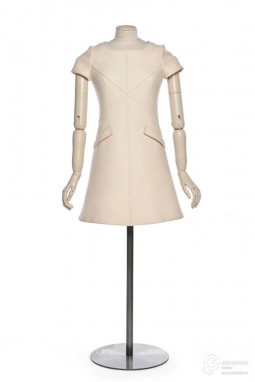
One of the leading figures of the introduction of the miniskirt in fashion and the designer of the famous boots, André Courrèges was the fashion designer who brought modernity into the world of French couture.
Born in 1923 in Pau, in the French Pyrenees, André Courrèges studied at the École Nationale des Ponts-et-Chaussées in Paris, as his father wanted him to become an engineer. However the civil engineer André Courrèges, who became a pilot in the France Air Force in World War II, decided after the war to change profession. In 1950, at the age of 28, he joined the house of Balenciaga, where he stayed for ten years, eventually becoming Critòbal Balenciaga’s First Assistant.
It was in 1961 when Courréges and his future wife Coqueline, with the help of Balenciaga himself, founded their own house. At the time, Courrèges courageously revitalized the world of French haute couture by importing elements of the “youthquake” which invested London in the early 1960s. He was, along with Mary Quant, a leading figure of the introduction of the miniskirt, to which he paired, in his collections, his trademark white kid boots.

Pair of leather ankle boots, designed by André Courrèges, Paris, 1965. Collection Victoria and Albert Museum, CC-BY-NC.
The influence of the designer’s background as engineer and his ten years spent working at Balenciaga were already visible in Courrèges early creations. His clothes, sharp and somehow minimalistic in style and construction, showed his sartorial knowledge, which improved the effect of his innovative creations. He also experimented with new materials, usually involving plastics in his designs.

Ensemble designed by André Courrèges, Paris, 1965 – 1970 ca. Collection ModeMuseum Hasselt, all rights reserved.
His programmatic collection, which would have defined his aesthetic, was shown in 1964. Entitled “Space Age”, it made the designer fortune – British Vogue declared 1964 “the year of Courrèges”. His debut in couture was in 1965, and two years later he presented “Prototype”, a made-to-order line. Courrèges entered the spirit of the Seventies with “Couture Future”, a luxury prêt-à-porter collection, along with a men’s ready to wear line in 1973. In order to reach a wider market, the designer also launched the lower-priced “Hyperbole” line in the early 1980s, and sold his company in 1985 to the Japanese firm Itokin, to solidify his brand name. Courrèges also designed some of the looks for the character portrayed by Audrey Hepburn in “Two for the Road” in 1967, and in 1972 he created the uniforms for the Olympic Games in Monaco.

Ensemble in dark brown wool designed by André Courrèges in 1972. Collection Gemeentemuseum Den Haag via Mode Muze, all rights reserved.
In 1994, the lead of his brand was passed to the hands of his wife Coqueline, while the designer focused on sculpture and painting. In 2002, Coqueline began developing the project of an electronic car – the first version of the car appeared in 1969 – which prototype named “Zooop EV” was well received by critics in 2008.
The designer died Thursday 7th January 2016 in Paris, at the age of 92, after a long battle with Parkinson’s disease. Browse Europeana Fashion collection to find more pictures of his modern creations.
A Special Headgear: the Crown!
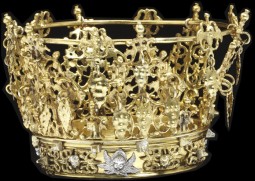
Crown, a special headgear to designate a ruler, exists in many civilizations around the world. Made of precious metals and often decorated with precious stones, it represents power, glory, immortality, royalty and sovereignty.
Precursor of modern crowns was the diadem, which was adopted by Constantine I and was, after him, worn by all rulers of the later Roman Empire. Roman Emperors also used the radian crown, as part of the cult of “Sol Invictus” before the Roman Empire converted to Christianity. The oldest Christian crown in Europe is probably the Iron Crown of Lombardy, used also during the coronation of Kings of Napoleonic and Austrian Italy and as a symbol of the united Italy after 1861.
In European countries which are based on Christian tradition, monarchic power is given from the power of the Church. Crowns, belonging to European tradition, are strongly connected to christian tradition too. When a new monarch was elected, the crown was placed on his head by a church official and most Holy Roman Emperors traveled to Rome to be crowned by a Pope. But royalty is not the only range in which this particular kind of headgear has been used in history.
In Sweden tradition, the crown is associated to the wedding as a common bridal accessory. Worn for the marriage ceremony, this accessory comes from the earlier maiden’s ringlet which consisted of a wreath with ribbons down the back, and has seen another version in circular headdress or tiara with colorful ribbons. The Bridal Wedding Crown, was fashioned out of metals such as brass, gold or silver which may also have had some wreathes of myrtle, and used to be worn on top of the veil.
This tradition, dates back to the Catholic times of the Middle Ages, comes from the iconic representation of Virgin Mary, who was always illustrated carrying a crown in earlier churches. For this reason the church requirement for bride to wear the Bridal Crown was that she must be a virgin. According to ethnologists, this tradition was an early way for church and society of controlling women’s sexuality. But it was in some cases possible to convince the priest to overlook a premature pregnancy with a bribe or sometimes by atoning for the sin by paying for a new gilding of the crown. Then, in the first decades of the 20th century, the use of wearing a crown started disappearing.
Visit Europeana Fashion Portal to find a huge selection of crowns from our archive and follow Wedding Dresses Curation on Europeana Fashion Tumblr.
The White Wedding Dress
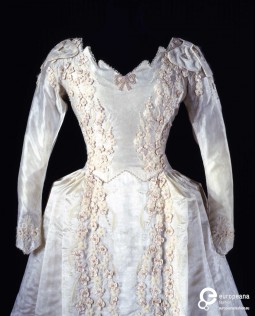
The first Europeana Fashion’s Tumblr curation of the year is dedicated to wedding gowns. Every day on our Tumblr it will be posted a picture selected from our collection to unveil the history of the white wedding gown!
Though white is today the colour mostly associated with Western wedding traditions, the white wedding gown became popular only after the second half of the 19th century, when the picture of the marriage of the Queen Victoria to Albert Saxe-Coburg was published in the most fashionable magazines of the time. The dress, that also dripped with orange blossoms, was white to incorporate some lace the Queen Victoria prized.

Queen Victoria and Prince Albert, Buckingham Palace, 11 May 1854 (after a Drawing Room), Roger Fenton, 11 May 1854. The Royal Collection © 2010, Her Majesty Queen Elizabeth II, via Wikimedia Commons.
The Queen Victoria wasn’t however the first queen to wear white in history. Before her, Philippa of England wore a tunic with a cloak in white silk in 1406, and Mary, the Queen of Scots, wore a white wedding gown in 1559 when she married Francis Dauphin of France, even though at the time white was the mourning colour for French queens. In spite of that, before the case of Queen Victoria made white a popular colour for weddings, it was usual for brides to wear colourful dresses at their marriage, and to use the dress again after the event. The choice of the dress then depended on the wealth of the family, elaborate dresses and expensive fabrics were used to show the bride’s social standing, while less privileged girls used to wear their best dress – usually in dark colours – at their wedding. A popular colour was blue, which was the colour originally associated with purity and virginity as it was connected to the Virgin Mary.

Dress in brown cotton with woven silver stripe motif and floral pattern in brown, worn as wedding gown, 1820-1830. Collection Gemeentemuseum den Haag via ModeMuze, all rights reserved.
White, instead, didn’t have anything to do with purity. The colour was a synonym of ostentatiousness, not only because of the expensiveness of white fabric, but also because the white dress couldn’t be worn a second time in a different occasion, showing that the bride could afford to buy a dress she would only wear once. Even after the second half of the 19th century, it was common for many women to wear different colours at their wedding, especially during War period, when the tight circumstances required women to find different solutions.

Wedding dress consisting of a silk gauze and lace bodice, skirt, satin sash, collar, cape and silk fragment, probably made in Great Britain or France, ca. 1872-1874. Collection Victoria and Albert Museum, CC-BY-SA.
The Tumblr curation will feature a selection of dresses from the late 19th century to the present, showing the evolution of the wedding silhouette in the western world. Drawing from the various archives of the different museum in our collection, the dresses will space geographically through all Europe and its neighbouring countries. Browse also our website to find more wedding gowns!










